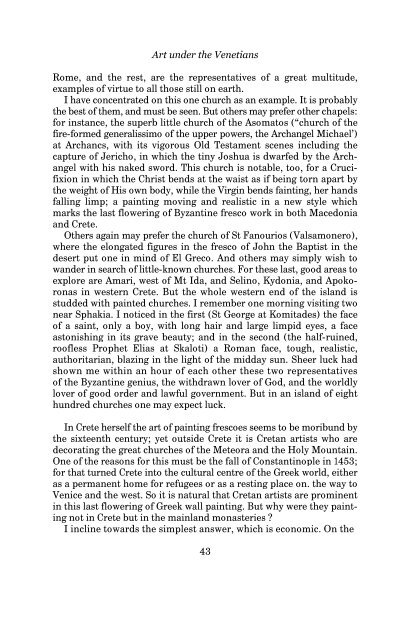free download here - Michael Llewellyn-Smith
free download here - Michael Llewellyn-Smith
free download here - Michael Llewellyn-Smith
Create successful ePaper yourself
Turn your PDF publications into a flip-book with our unique Google optimized e-Paper software.
Art under the Venetians<br />
Rome, and the rest, are the representatives of a great multitude,<br />
examples of virtue to all those still on earth.<br />
I have concentrated on this one church as an example. It is probably<br />
the best of them, and must be seen. But others may prefer other chapels:<br />
for instance, the superb little church of the Asomatos (“church of the<br />
fire-formed generalissimo of the upper powers, the Archangel <strong>Michael</strong>’)<br />
at Archancs, with its vigorous Old Testament scenes including the<br />
capture of Jericho, in which the tiny Joshua is dwarfed by the Archangel<br />
with his naked sword. This church is notable, too, for a Crucifixion<br />
in which the Christ bends at the waist as if being torn apart by<br />
the weight of His own body, while the Virgin bends fainting, her hands<br />
falling limp; a painting moving and realistic in a new style which<br />
marks the last flowering of Byzantine fresco work in both Macedonia<br />
and Crete.<br />
Others again may prefer the church of St Fanourios (Valsamonero),<br />
w<strong>here</strong> the elongated figures in the fresco of John the Baptist in the<br />
desert put one in mind of El Greco. And others may simply wish to<br />
wander in search of little-known churches. For these last, good areas to<br />
explore are Amari, west of Mt Ida, and Selino, Kydonia, and Apokoronas<br />
in western Crete. But the whole western end of the island is<br />
studded with painted churches. I remember one morning visiting two<br />
near Sphakia. I noticed in the first (St George at Komitades) the face<br />
of a saint, only a boy, with long hair and large limpid eyes, a face<br />
astonishing in its grave beauty; and in the second (the half-ruined,<br />
roofless Prophet Elias at Skaloti) a Roman face, tough, realistic,<br />
authoritarian, blazing in the light of the midday sun. Sheer luck had<br />
shown me within an hour of each other these two representatives<br />
of the Byzantine genius, the withdrawn lover of God, and the worldly<br />
lover of good order and lawful government. But in an island of eight<br />
hundred churches one may expect luck.<br />
In Crete herself the art of painting frescoes seems to be moribund by<br />
the sixteenth century; yet outside Crete it is Cretan artists who are<br />
decorating the great churches of the Meteora and the Holy Mountain.<br />
One of the reasons for this must be the fall of Constantinople in 1453;<br />
for that turned Crete into the cultural centre of the Greek world, either<br />
as a permanent home for refugees or as a resting place on. the way to<br />
Venice and the west. So it is natural that Cretan artists are prominent<br />
in this last flowering of Greek wall painting. But why were they painting<br />
not in Crete but in the mainland monasteries ?<br />
I incline towards the simplest answer, which is economic. On the<br />
43


